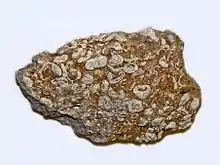Sphaerocodium
Sphaerocodium is a fossil that represents the remains of bacteria in the phylum Cyanobacteria, often called blue-green algae.[1][2]
| Sphaerocodium | |
|---|---|
 | |
| Sphaerocodium kokeni From Triassic of Germany | |
| Scientific classification | |
| Domain: | |
| Kingdom: | |
| Phylum: | |
| Genus: | † Sphaerocodium Rothpletz, 1908 |
The species of Sphaerocodium recorded by the author Rothpletz could be symbiotic intergrowths of different encrusting organisms. Two new genera (Rothpletzella and Wetheredella) have been proposed to include these forms.[3]
Sphaerocodium is characterised by having dichotomously-branching tubular filaments made of calcite, which formed encrusting masses on objects. These filaments branch in a fanlike pattern but remain in contact with each other; each filament is approximately 40-100μm wide and 30-50μ high. Filaments are not divided by septa.[4]
Sphaerocodium was formerly assigned to the now-obsolete family porostromata.[5]
Fossil record
This genus is known in the fossil record from the Ordovician to the Triassic (from about 460.9 to 221.5 million years ago). Fossils of species within this genus have been found in Europe, Russia, United States, Canada, China and Australia.[6]
References
- "Sphaerocodium". fossiilid.info. Retrieved 7 January 2019.
- E. Flügel Fossil Algae: Recent Results and Developments
- Alan Wood, Ph.D., F.G.S “Sphaerocodium,” a misinterpreted Fossil from the Wenlock limestone
- "Calcareous algae, Volume 4 - 1st Edition". www.elsevier.com. Retrieved 2020-09-28.
- Monty, C. L. (1981). Monty, Claude (ed.). "Spongiostromate vs. Porostromate Stromatolites and Oncolites". Phanerozoic Stromatolites. Berlin, Heidelberg: Springer: 1–4. doi:10.1007/978-3-642-67913-1_1. ISBN 978-3-642-67913-1.
- "Fossilworks: Sphaerocodium". fossilworks.org. Retrieved 7 January 2019.